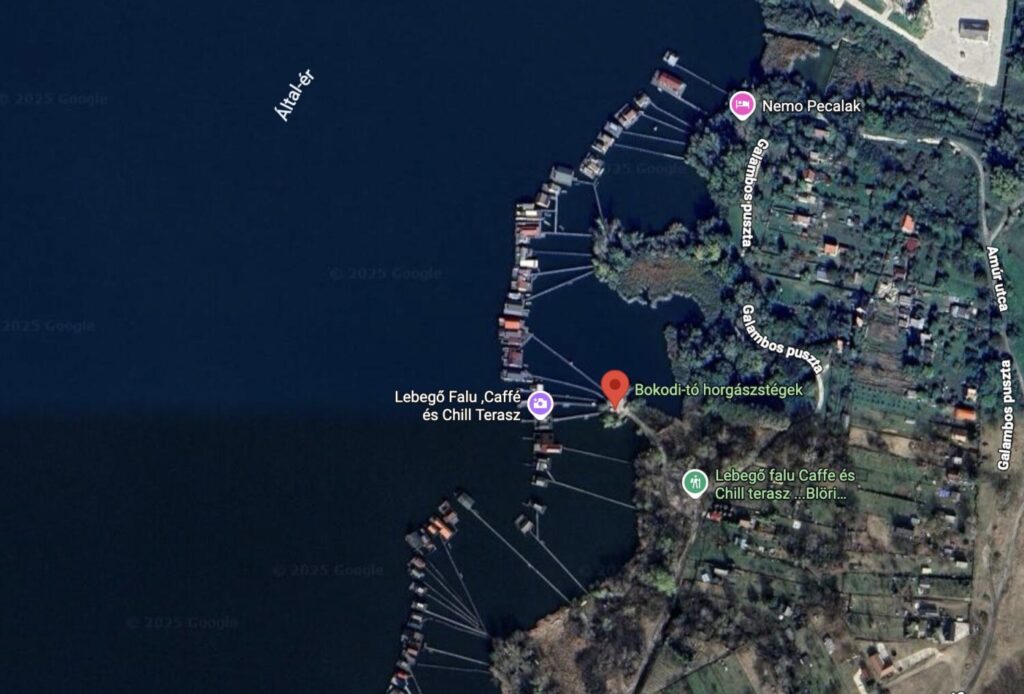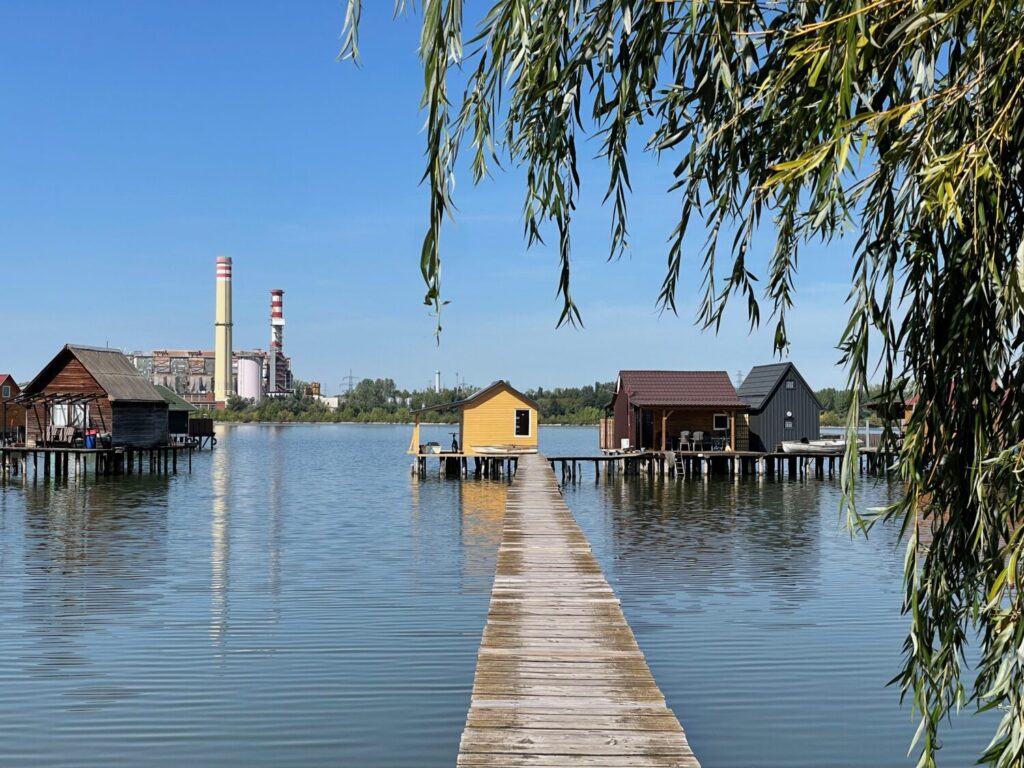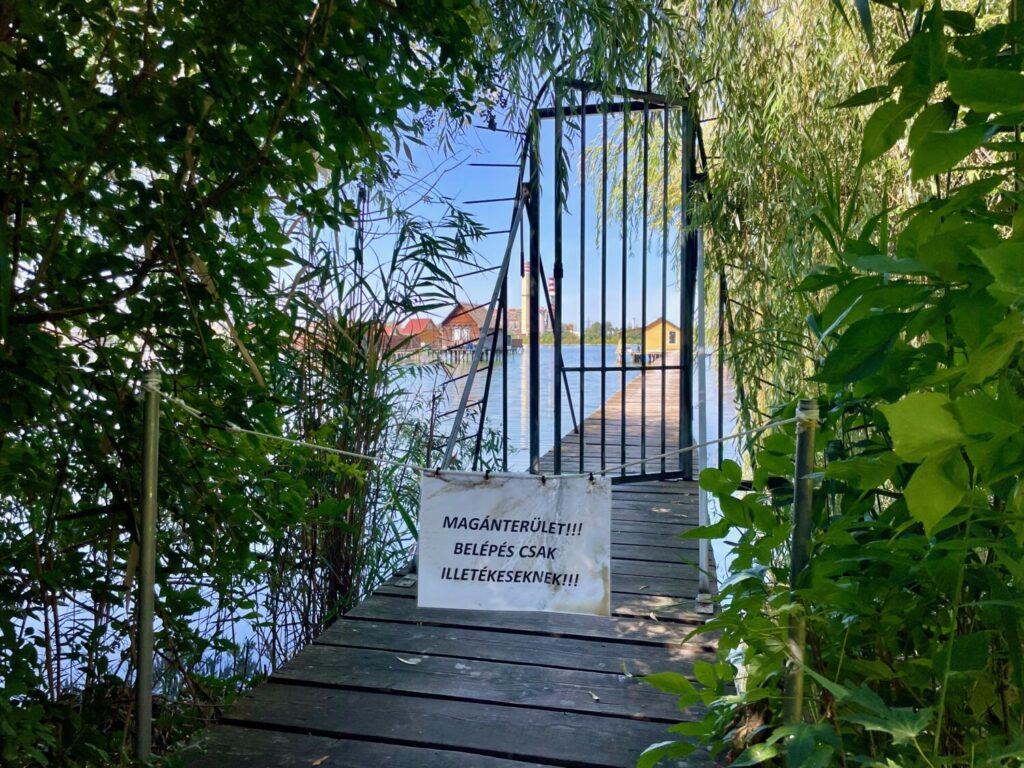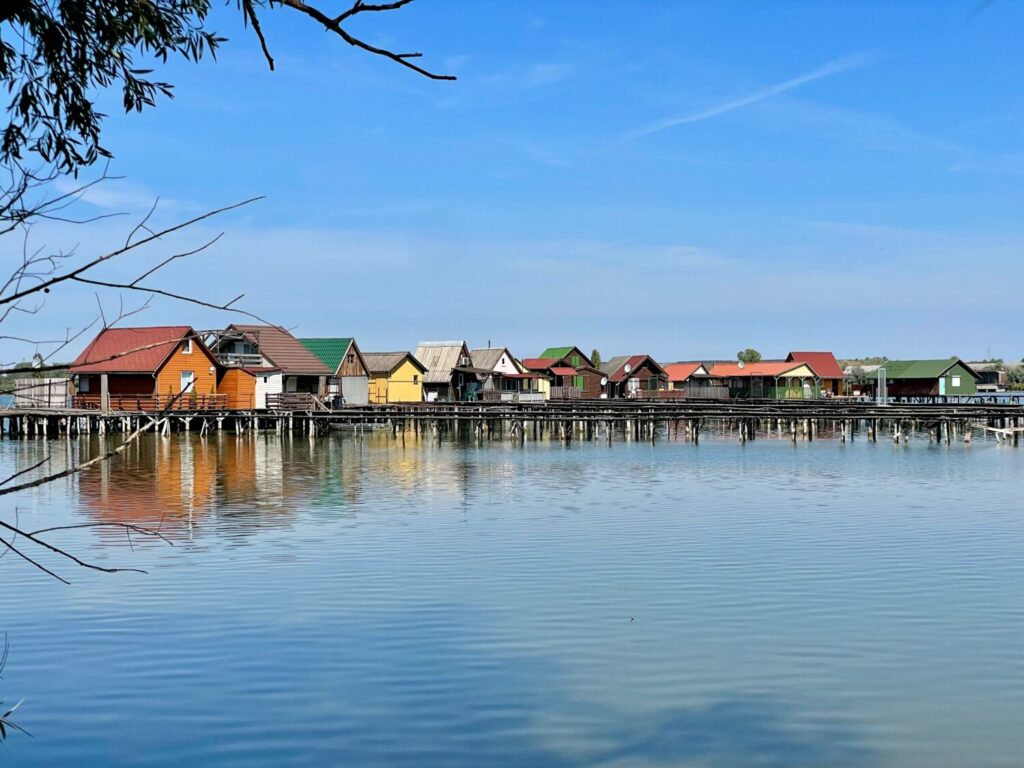Hidden in north-western Hungary, near the former mining town of Oroszlány, Lake Bokodi is home to one of the country’s most fascinating curiosities: a floating village that embodies the blend of industrial heritage and human creativity. What began as a cooling pond for a coal-fired power plant has become a serene landscape of wooden boardwalks and colourful fishing huts standing gracefully above the water. Today, it attracts photographers, curious travellers and anyone drawn to unusual places. In this article, you’ll discover the story behind Lake Bokodi and whether it’s worth adding to your Hungary itinerary.
Table of Contents
What Is Lake Bokodi: Hungary’s Hidden Floating Village
The Hungarian name Bokodi-hűtőtó literally means ‘Bokodi Cooling Lake’. This artificial lake, located near Oroszlány, was created in 1961. The Vértes Power Plant dammed the Által River to produce a reservoir of cooling water for their coal-fired station. Although entirely artificial, Lake Bokodi looks remarkably natural, surrounded by the wooden houses that seem to float above the surface.
PLAN YOUR TRIP TO HUNGARY
For a road trip in Hungary, choose a Holafly eSIM: you will have unlimited internet to use Google Maps or any other GPS app, and you can share photos and videos in real time on WhatsApp and social media without any worries.
To travel with complete peace of mind, don’t forget to also take out Heymondo travel insurance, which protects you from unexpected events and ensures a worry-free holiday.
The main feature of the area is that, for many years, Lake Bokodi never froze, even during Hungary’s coldest winters, as a direct result of the continuous circulation of warm water from the power plant. For this reason, it was possible to fish here all year round, transforming the area into a Hungarian fishing paradise.
Local fishermen and power plant workers built the small wooden houses on piles and connected them by narrow plank walkways. Over time, they created a one-of-a-kind landscape. Online, I read that the area has earned the nickname ‘the Hungarian Bora Bora’. However, the comparison is only for wooden houses on piles, not for luxury.
Today, even though the power plant has long since closed, the floating houses still line the lake. Although it is no longer as popular as it once was, the floating village still offers a glimpse into a unique chapter of Hungary’s industrial and cultural history.

Lake Bokodi History: From Industrial Heritage to Fishing Paradise
Lake Bokodi was created in the early 1960s, when the nearby Vértes Power Plant Ltd (Vértesi Erőmű Zrt in Hungarian) dammed the Által River to supply cooling water for its coal-fired thermal power station in Oroszlány in 1960.
The surrounding meadows slowly filled with water, forming a new artificial lake. The power plant itself was built the following year, in 1961, and the lake soon became an essential part of its operation.
The system had a dual purpose, acting as both a cooling basin and a water reservoir. The plant’s condensers released used hot water into the lake, where it cooled naturally through surface evaporation and mixing with the existing water. As a result of this industrial process, the lake maintained a consistently mild temperature. The continuous circulation of warm water prevented the lake from freezing in winter, allowing fish to thrive all year round and giving rise to a vibrant fishing community.
Except for the area near the northern dam and the former power plant, much of the shoreline became lined with small wooden fishing houses built on piles, connected to the banks by long, narrow piers made of wooden planks. Local workers and residents began constructing modest cabins for weekend stays, gradually transforming the site into what is now known as Hungary’s floating village.
This creative adaptation dates back to the communist era, when Hungarians were unable to travel abroad, and people found imaginative ways to relax and spend their leisure time closer to home.
When the Vértes Power Plant ceased operations in 2015, the water temperature eventually returned to normal, and fishing activity faded away. Yet the distinctive landscape of Lake Bokodi remains, a tranquil reminder of how industry and nature can unexpectedly coexist to create beauty.

Visiting Lake Bokodi Today and What to See at the Floating Village
The Bokodi floating village is one of the most photographed attractions around Oroszlány, and the only floating village in Hungary. Its wooden houses on stilts, standing over the calm surface of the lake, create a truly picturesque sight that attracts photographers and travellers looking for something unique and off the beaten path.
Although the power station stopped operating in 2015, the water temperature eventually returned to normal, and fishing activity faded away, the wooden cabins and their quiet, nostalgic atmosphere remain.
The houses are privately owned and still used by local families, so access to the walkways is restricted. Most piers are blocked by gates marked with no entry signs, meaning it’s not possible to explore the floating village up close.
You can just stop at the entrances of the small access roads, take photos from a respectful distance, and enjoy the view of the colourful houses reflected on the water. There isn’t much to see beyond the scenic panorama, but even a short stop is worthwhile for those curious about Hungary’s industrial and rural past.
If you’d like to understand more about the area’s history, the nearby Mining Museum of Oroszlány offers an excellent introduction to the region’s coal-mining heritage and the people who lived and worked here.

Lake Bokodi Floating Village: Is It Worth Visiting?
To be honest, Lake Bokodi isn’t worth a dedicated day trip. We stopped there while travelling from Oroszlány to Lake Balaton, during our road trip in Hungary. It felt like a good idea to visit this famous floating village along the route, but we were already on our way.
Getting there isn’t so easy. Google Maps will take you roughly to the right place if you search for “Bokodi floating village”, but the last few kilometres are along unpaved dirt roads that follow the lakeshore. You can park your car near the end of the road and reach the water’s edge on foot, where the floating cottages appear just a few steps away.
A few years ago, Lake Bokodi became an internet sensation, featured in viral social media posts and even in National Geographic. Today, however, the atmosphere is quieter and less lively.
We didn’t find the “café and chill terrace” we’d read about. Instead, our GPS led us down forest paths and muddy tracks with no sign of lakeside infrastructure.
Technically, the shore belongs to the old power plant, and you’re free to walk along it. Still, in practice, the area is mostly private property. All walkways had “no entry” signs, so you can only see the floating village from the shore.
Apart from taking a few photos, there’s not much else to do. In my opinion, Lake Bokodi isn’t worth a long detour or a trip by public transport from Budapest. Yet, if you’re already travelling nearby and curious about Hungary’s floating village, it’s an interesting and unusual stop, a brief glimpse of how nature has reclaimed an industrial past.
How to Get to Lake Bokodi from Budapest and Nearby Towns
Lake Bokodi is located about 80 kilometres west of Budapest, between the villages of Bokod and Oroszlány. The easiest way to reach it is by car, taking the M1 motorway towards Győr and then following local roads to Oroszlány. The drive takes around 90 minutes from the capital.
Once you reach the area, you’ll notice that the access roads are unpaved and in poor condition, especially near the lakeshore. It’s best to park your car where you see other vehicles and continue on foot for the final part of the journey.
There are no direct public transport links from Budapest, and even regional buses stop far from the lake, so driving remains the most practical option for visiting Lake Bokodi as a half-day or short stopover trip.
Bokodi-tó Horgászstégek
(Bokodi Floating Village)
Erőműi tópart, 2840 Oroszlány

Final Thoughts on Bokodi Floating Village: A Curious Stop off the Beaten Path
Lake Bokodi offers a fascinating glimpse into Hungary’s industrial past and serves as a perfect example of how nature and creativity can transform even the most unexpected places. Although it’s not a must-see destination, it’s an intriguing stop for curious travellers exploring western Hungary. Let me know in the comments if you have visited Lake Bokodi or discovered any similar hidden spots in Hungary.
